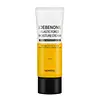THE LAB by blanc doux Oligo Hyaluronic Acid Healthy Cream Cushion Versus Sidmool Idebenone Elastic Force Moisture Cream
What's inside
What's inside
 Key Ingredients
Key Ingredients

 Benefits
Benefits

 Concerns
Concerns

No concerns
 Ingredients Side-by-side
Ingredients Side-by-side

Water
Skin ConditioningZinc Oxide
Cosmetic ColorantTitanium Dioxide
Cosmetic ColorantButyloctyl Salicylate
Skin ConditioningCaprylyl Methicone
Skin ConditioningButylene Glycol Dicaprylate/Dicaprate
EmollientGlycerin
HumectantPhenyl Trimethicone
Skin ConditioningCaprylic/Capric Triglyceride
MaskingIsododecane
EmollientPolyglyceryl-3 Polyricinoleate
EmulsifyingTrimethylsiloxysilicate
EmollientNiacinamide
SmoothingMethyl Hydrogenated Rosinate
PerfumingMethylpropanediol
SolventCI 77891
Cosmetic ColorantPolyglyceryl-4 Isostearate
EmulsifyingDisteardimonium Hectorite
StabilisingHydrolyzed Hyaluronic Acid
HumectantSodium Chloride
MaskingCaprylic/Capric Glycerides
EmollientSorbitan Isostearate
EmulsifyingCetyl Alcohol
EmollientPolyglyceryl-3 Ricinoleate
EmulsifyingTriethoxycaprylylsilane
Copernicia Cerifera Wax
Dimethicone/Vinyl Dimethicone Crosspolymer
Skin ConditioningAdenosine
Skin ConditioningCI 77492
Cosmetic ColorantCI 77491
Cosmetic ColorantCI 77499
Cosmetic ColorantWater, Zinc Oxide, Titanium Dioxide, Butyloctyl Salicylate, Caprylyl Methicone, Butylene Glycol Dicaprylate/Dicaprate, Glycerin, Phenyl Trimethicone, Caprylic/Capric Triglyceride, Isododecane, Polyglyceryl-3 Polyricinoleate, Trimethylsiloxysilicate, Niacinamide, Methyl Hydrogenated Rosinate, Methylpropanediol, CI 77891, Polyglyceryl-4 Isostearate, Disteardimonium Hectorite, Hydrolyzed Hyaluronic Acid, Sodium Chloride, Caprylic/Capric Glycerides, Sorbitan Isostearate, Cetyl Alcohol, Polyglyceryl-3 Ricinoleate, Triethoxycaprylylsilane, Copernicia Cerifera Wax, Dimethicone/Vinyl Dimethicone Crosspolymer, Adenosine, CI 77492, CI 77491, CI 77499
Water
Skin ConditioningGlycerin
HumectantButylene Glycol
HumectantHydrogenated Lecithin
EmulsifyingSucrose
HumectantGlucose
HumectantFructose
HumectantBeta-Glucan
Skin ConditioningHydroxydecyl Ubiquinone
AntioxidantSorbitol
HumectantErythritol
HumectantXanthan Gum
EmulsifyingHydrogenated Polyisobutene
EmollientCaprylic/Capric Triglyceride
MaskingTocopherol
AntioxidantDipotassium Glycyrrhizate
HumectantAllantoin
Skin ConditioningEthylhexylglycerin
Skin ConditioningPropanediol
SolventChamaecyparis Obtusa Branch/Leaf Extract
HumectantWater, Glycerin, Butylene Glycol, Hydrogenated Lecithin, Sucrose, Glucose, Fructose, Beta-Glucan, Hydroxydecyl Ubiquinone, Sorbitol, Erythritol, Xanthan Gum, Hydrogenated Polyisobutene, Caprylic/Capric Triglyceride, Tocopherol, Dipotassium Glycyrrhizate, Allantoin, Ethylhexylglycerin, Propanediol, Chamaecyparis Obtusa Branch/Leaf Extract
 Reviews
Reviews

Ingredients Explained
These ingredients are found in both products.
Ingredients higher up in an ingredient list are typically present in a larger amount.
This ingredient is an emollient, solvent, and texture enhancer. It is considered a skin-softener by helping the skin prevent moisture loss.
It helps thicken a product's formula and makes it easier to spread by dissolving clumping compounds.
Caprylic Triglyceride is made by combining glycerin with coconut oil, forming a clear liquid.
While there is an assumption Caprylic Triglyceride can clog pores due to it being derived from coconut oil, there is no research supporting this.
Learn more about Caprylic/Capric TriglycerideGlycerin is already naturally found in your skin. It helps moisturize and protect your skin.
A study from 2016 found glycerin to be more effective as a humectant than AHAs and hyaluronic acid.
As a humectant, it helps the skin stay hydrated by pulling moisture to your skin. The low molecular weight of glycerin allows it to pull moisture into the deeper layers of your skin.
Hydrated skin improves your skin barrier; Your skin barrier helps protect against irritants and bacteria.
Glycerin has also been found to have antimicrobial and antiviral properties. Due to these properties, glycerin is often used in wound and burn treatments.
In cosmetics, glycerin is usually derived from plants such as soybean or palm. However, it can also be sourced from animals, such as tallow or animal fat.
This ingredient is organic, colorless, odorless, and non-toxic.
Glycerin is the name for this ingredient in American English. British English uses Glycerol/Glycerine.
Learn more about GlycerinWater. It's the most common cosmetic ingredient of all. You'll usually see it at the top of ingredient lists, meaning that it makes up the largest part of the product.
So why is it so popular? Water most often acts as a solvent - this means that it helps dissolve other ingredients into the formulation.
You'll also recognize water as that liquid we all need to stay alive. If you see this, drink a glass of water. Stay hydrated!
Learn more about Water